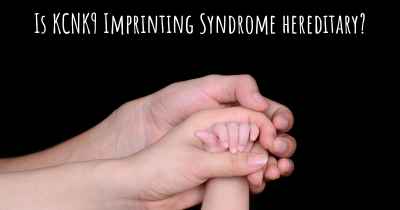What is the history of KCNK9 Imprinting Syndrome?
When was KCNK9 Imprinting Syndrome discovered? What is the story of this discovery? Was it coincidence or not?

KCNK9 Imprinting Syndrome, also known as Temple Syndrome, is a rare genetic disorder that affects the regulation of certain genes on chromosome 8. This condition was first described in 2010 by Temple et al., hence the name Temple Syndrome. It is characterized by a range of physical and developmental abnormalities, including growth restriction, intellectual disability, and distinctive facial features.
Genomic imprinting is a phenomenon where certain genes are expressed in a parent-of-origin-specific manner. In most cases, each gene copy inherited from the mother and father is equally active. However, in imprinted genes, one copy is silenced, and only the copy from either the mother or father is expressed. KCNK9 is one such imprinted gene, and alterations in its expression can lead to KCNK9 Imprinting Syndrome.
The KCNK9 gene is located on chromosome 8 and encodes a protein called K2P9.1, which is involved in the regulation of ion channels in the brain. These ion channels play a crucial role in the transmission of electrical signals between nerve cells. Disruptions in the expression or function of K2P9.1 can lead to abnormal brain development and function, contributing to the symptoms observed in individuals with KCNK9 Imprinting Syndrome.
The exact cause of KCNK9 Imprinting Syndrome is not yet fully understood. However, it is known to be associated with genetic alterations in the region of chromosome 8 where the KCNK9 gene is located. These alterations can include deletions, duplications, or mutations that affect the normal regulation of the gene. The specific genetic changes involved can vary among affected individuals, which contributes to the variability in the severity and presentation of the syndrome.
The clinical features of KCNK9 Imprinting Syndrome can vary widely, even among affected individuals within the same family. However, some common characteristics have been identified. These include intrauterine growth restriction, which means affected individuals have slow growth while in the womb, resulting in low birth weight. After birth, they may continue to have failure to thrive and exhibit short stature compared to their peers.
Distinctive facial features are often observed in individuals with KCNK9 Imprinting Syndrome. These may include a prominent forehead, low-set ears, wide nasal bridge, and a small mouth. Additionally, affected individuals may experience developmental delays and intellectual disability, ranging from mild to severe.
Diagnosis of KCNK9 Imprinting Syndrome is typically based on clinical features and confirmed through genetic testing. Genetic testing can identify alterations in the KCNK9 gene or the surrounding region of chromosome 8. Prenatal diagnosis is also possible through chorionic villus sampling or amniocentesis for families with a known KCNK9 gene alteration.
Management of KCNK9 Imprinting Syndrome involves a multidisciplinary approach to address the various medical, developmental, and educational needs of affected individuals. This may include regular monitoring of growth and development, early intervention services, physical and occupational therapy, and educational support tailored to the individual's abilities and needs.
In conclusion, KCNK9 Imprinting Syndrome is a rare genetic disorder caused by alterations in the KCNK9 gene on chromosome 8. It is associated with a range of physical and developmental abnormalities, including growth restriction, intellectual disability, and distinctive facial features. While the exact cause and mechanisms of the syndrome are still being investigated, early diagnosis and comprehensive management can help improve the quality of life for individuals with KCNK9 Imprinting Syndrome.








